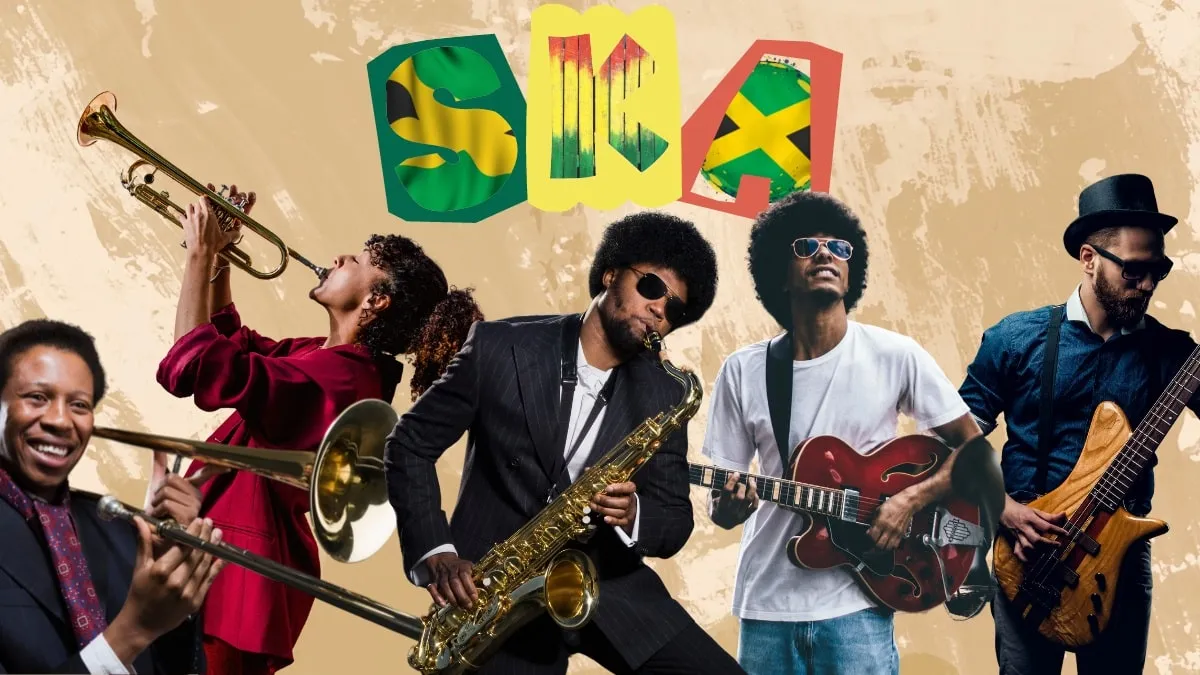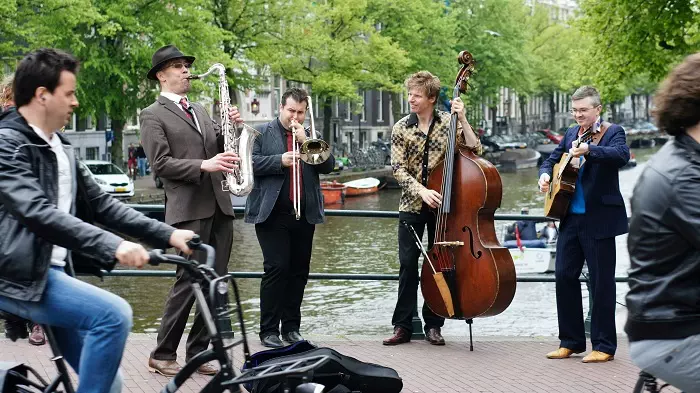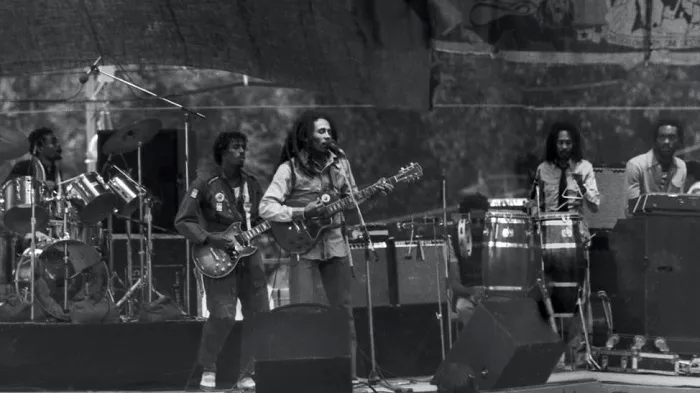A lot of beautiful things were born in Jamaica. Blue Mountain Coffee, Jamaican rum, and last but not least, Bob Marley.
The island has a unique personality, reflected in its luxurious resorts, majestic beaches, and eccentric music genres.
Everything about the island is unique, even its flag. It’s the only flag in the world that doesn’t have red, white, or blue in its color combination.
But we’re not here to talk about Jamaica’s flag or beaches; we’re talking about the exceptional music genres the island gave birth to.
Ska music is believed to have laid the foundation for reggae and other music genres that later followed. Some people describe it as the bridge between Jamaican music and punk music. Others say it’s the rock equivalent of Jamaican people, and many Jamaicans are convinced it’s calypso music with a jazz influence.
We’ll tell you everything there is to know about the genre, and you can decide for yourself how to describe it!
What Is Ska Music?
Ska is fast dance music that became known to the world in the late ‘50s. It’s known for combining Jamaican mento rhythms with American rhythm and blues. And, it uses jazzy instruments like trumpets, trombones, and saxophones to give the mento vibes.
The guitar is also one of the main instruments of ska.
The songs of this genre have frequent jumpy rhythms, and the lyrics are more often than not talking about local issues.
The music is considered a bridge between American punk music, British dance music, and Jamaican music. We can say this is true, especially that the genre combines various musical influences.
However, punk music rose to popularity in the ‘90s, and British dance music didn’t hit the charts until the ‘70s. Ska music was created long before that—specifically in the ‘60s. So, we can say it got influenced by both genres, but it preceded them both.
The primary characteristic of ska music is a skank, which is a guitar-strumming technique that’s widely used in reggae, ska, and rocksteady. Skank is also a dancing style performed with ska and reggae music, but that’s a story for another day.
The skank involves adding a guitar chop on the bass line’s offbeat. It’s often added right after a horn, and a piano piece follows it to pick up the bass line again.
The skank guitar strum isn’t exclusive to ska. It’s derived from mento and calypso genres, which are old Caribbean styles that inspired ska and reggae. Some people also believe it’s derived from the shuffle, which is a form of R&B arrangement frequently used in Jamaican blues parties.
The Main Instruments of Ska Music
The main instruments of ska music are the guitar, bass, and brass instruments.
The electric guitar is an integral part of the genre. The artists utilize barre chords, emphasizing EBG strings, in particular. They also often create syncopations to get high-frequency riffs.
On the other hand, the bass guitar is the one responsible for the melody. Most ska songs feature a walking bassline, which means the bass notes constantly move up and down the scale.
This gives ska its Jazz feel. Without it, it’d sound a lot like mento music.
As for the bass instruments or the horn section, we believe it’s essential to ska music. A horn section typically consists of a trombone, a trumpet, and a saxophone. These instruments are responsible for the Jamaican rhythms; they provide the rhythmic accompaniment of the songs.
A lot of other instruments are used, but these are the main ones.
The 4 Main Characteristics of Ska Music
Each music genre has some characteristics that define it. For example, jazz has the swing, bent notes, distinctive voices, and improvisation. Meanwhile, rock has electric guitars, drums, harmonica, and double bass.
Likewise, ska music has four main characteristics that define it. Here’s an overview of all of them.
Rock and Jazz Instruments
Rock instruments make most ska bands. Any ska band depends on bass, guitar, drums, and lead vocals. On top of that, saxophones, trombones, trumpets, and other jazz instruments are also vital to create Jamaican vibes.
Some ska bands use keyboards, but the rock and jazz instruments are the main components of any band.
Instrumental Riffs and Horn Sections
Nearly all ska songs have instrumental riffs played by the horn sections. The players mostly add the riffs between the sung vocals as a way to fill the gap.
4/4 Time Signature
It doesn’t come as a surprise that 4/4 is the primary time signature of ska music. It’s the most common time signature among all, and it’s used in all dance music genres.
So, all ska songs are written in 4/4 time, and the beats are played at a brisk pace to create the desired effects.
Sometimes, the music has additional beats to create a jazz rhythm. For example, the drummers sometimes put emphasis on the backbeat by adding beats of two and four. In addition to that, the bass guitarist can play a mix of eighth and quarter notes to give an active feel to the music.
Lyrics About Social Justice
The fourth main characteristic of ska music is the main topic of the lyrics: social justice. Most ska songs talk about racial integration, equity, and other local issues. However, that was primarily in the first and the second waves.
In the third wave, the topics went broader to include nearly everything. In fact, only a few ska songs now include the topics of social justice.
The Full History of Ska Music: The Three Waves Evolution
From its start as a bunch of mento rhythms and until today, ska music went through three waves. In those three waves, it went across three continents around the globe, and it inspired multiple genres that shortly followed.
Here’s an overview of the three waves.
The First Wave: A Trial Gone Wrong or Incredibly Well?
After the second world war was over, American music started getting broadcasted across the globe through radio stations. In this period, the Jamaicans received the American rhythms—particularly from the radio stations in Miami and New Orleans.
As a result of this, rhythm and blues songs were blasting across the country, which inspired many Jamaican artists to try their luck in recreating the genre.
Many Jamaican producers started recording aspiring local artists, singing their own version of R&Bs. However, because the Jamaican culture is incredibly rich, the artists couldn’t help but add their country’s influence to the songs.
So, while the songs were originally intended to have the soul of American R&B, they turned out infused by the Jamaican culture. For example, they were heavily influenced by Calypso, which is an Afro-Caribbean genre. Additionally, they had bits of mento music, which is Jamaican folk music.
It was a surprise, and the genre took a whole new form—moving further from R&B and closer to the Jamaican scene. The result was ska music, which rose to popularity in the early ‘60s.
At that time, it was the leading genre in Jamaica.
The Second Wave: Ska in the United Kingdom
The second wave of ska music was all about Britain. In the late ‘70s, a massive wave of Jamaican immigration arrived in the UK, and typically a lot of the island’s culture arrived along with it.
As a result, a new form of ska emerged, combining the first wave ska and punk rock elements. The music was called ‘2-Tone music,’ and it was more uptempo than the first wave music.
It’s believed that Jerry Dammers was the one to lay the foundation of second-wave ska. He formed a ska revival band called The Specials. Not only that but the second wave was also named after his records label, 2 Tone Records.
There’s another theory that says the music was called 2-tone because the band was racially integrated. You may think it’s not a big deal, and it’s not now, but it was a rarity back then.
The band’s lyrics leaned into politics and fighting racism, and the Thatcher-era in the UK was the excellent battlefield to put out socially concerned music.
Several other bands shortly followed, including The Selecter, Madness, and Bad Manners. Some bands even made it to Canada, such as The Villians. It later became the country’s most renowned ska band.
Thanks to 2-Tone music, the ska genre reached mainstream audiences in Britain, and the second wave progressed.
The Third Wave: Ska Punk Music
Shortly after ska music hit the charts in the UK, the Americans started picking up on 2-Tone music. Then, punk artists started merging ska influences with their music, creating a new genre: ska-punk music.
In this phase, ska was far removed from its origins. The music no longer had Jamaican vibes, instead revolving around punk rock elements. The horn section riffs were replaced with punchy guitar riffs, and the original ska only kept its initial form in Jamaica, its birthplace.
In the mid-nineties, the ska-punk genre reached unrivaled success. Artists like Reel Big Fish and Sublime started gaining mainstream audiences, and some of them appeared on the Billboard 200.
And just like that, a new genre was born.
What’s the Difference Between Ska, Rocksteady, and Reggae?
All Jamaican genres have crossovers with each other. That’s why it’s common to see comparisons between ska and reggae, ska and rocksteady, and so on.
What most people don’t know is, ska is the ancestor of most modern Jamaican music genres. Both rocksteady and reggae stemmed from it, although reggae had much more success in global recognition.
Here’s an explanation of the three genres and the differences between them.
Ska Gave Birth to Rocksteady
Rocksteady is the first and earliest descendant of ska music. While ska music emerged in the late ‘50s and early ‘60s, the rocksteady genre rose to popularity in the mid-sixties. By then, ska was slowly setting like the sun over the horizon, preparing for a remarkable revival in the UK.
Both ska and rocksteady are similar in terms of rhythms because they depend on the offbeat rhythm. If you play a ska rhythm at 80 bpm, you’ll hear a rocksteady groove. So, the genres aren’t too far from each other.
The main difference between them is the speed at which they’re played. Ska is incredibly fast, and its second wave became even more uptempo. Meanwhile, rocksteady has a laid-back rhythm, and it’s slower than its ancestor.
As a result of the music’s slow pace, some players started improvising the simple offbeat. They added more complex accents than the standard 2 and 4.
And the bass players started adding syncopation, which is basically a displacement of the regular accents. This technique was more popular in reggae music, though.
With piano, guitar, and bass players experimenting and adding their own accents to the music, the horn section took a seat in the back, mainly having a supportive role and leaving the lead for other instruments.
Reggae Shortly Followed
Rocksteady became incredibly popular in Jamaica. But music is constantly evolving and turning over genres.
A genre comes out, makes unrivaled success, and the heyday ends. A new genre then follows and takes the lead before taking a backseat after a while too.
Some genres remain forever engraved in people’s minds, and others get forgotten in the pages of history.
That’s exactly what happened with rocksteady and reggae. The latter took the lead after a while with its laid-back feel and legendary artists like Bob Marley.
Reggae is slower than both ska and rocksteady. It’s different from ska because it minimizes the use of horns, instead focusing on rock instruments. And, it’s different from rocksteady because of its basslines.
Both reggae and rocksteady have similar tempos, and they have the same accents on the offbeat. However, reggae depends more on syncopated basslines, while rocksteady leans towards simpler walking basslines.
Reggae music also has more Jamaican elements with the laid-back tempo and all. On the other hand, Rocksteady is more like the American Motown genre.
Other differences between ska and reggae include the bass, which is more prominent in reggae music. The genre also gives a bigger role to the guitar, which gives reggae its steady rhythm with its double strums.














